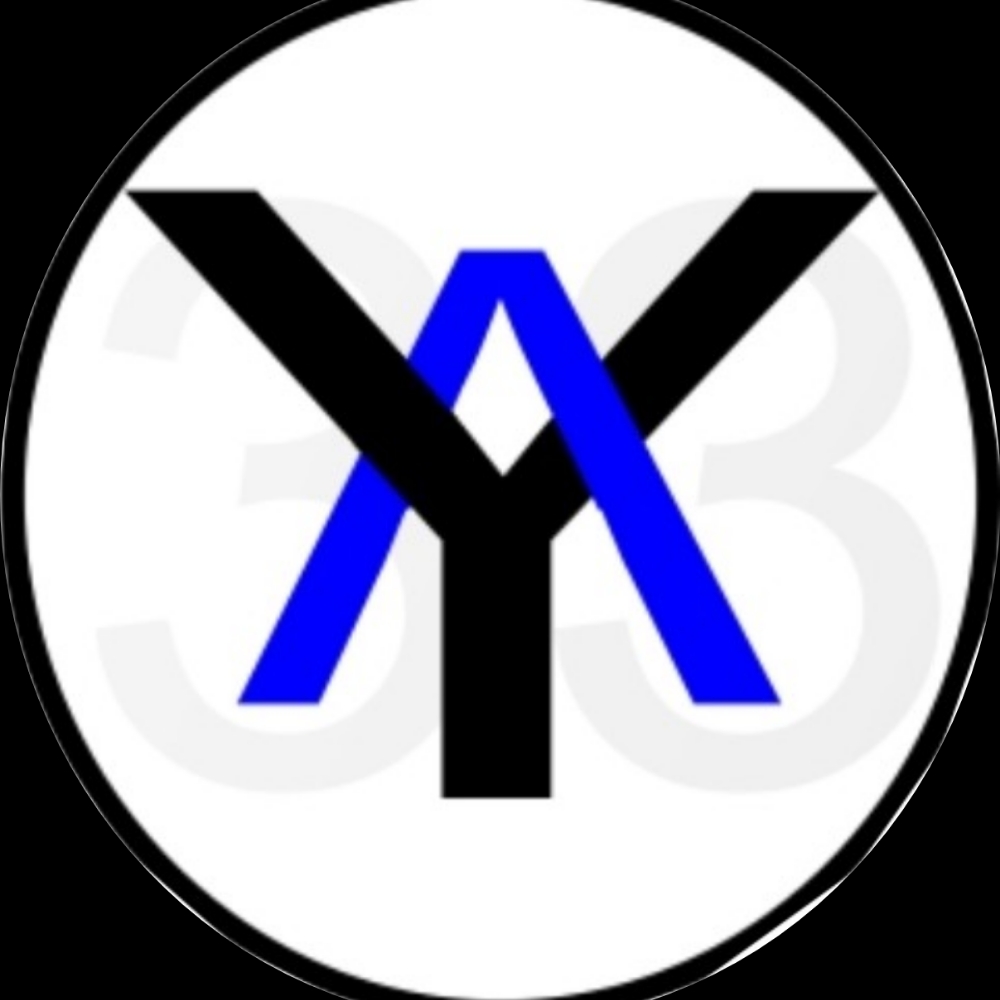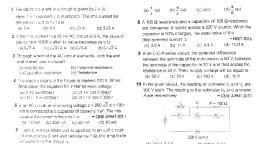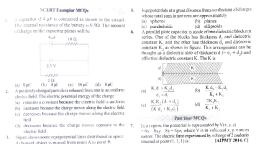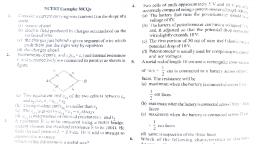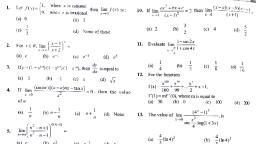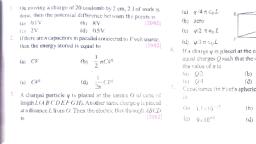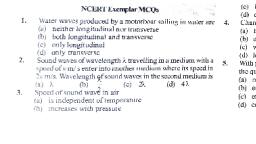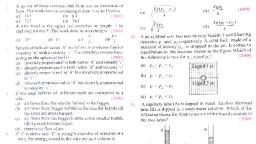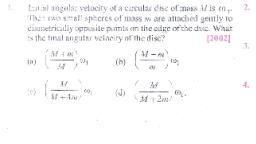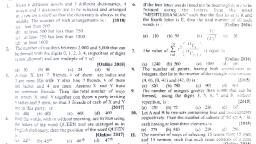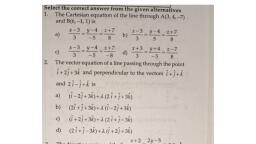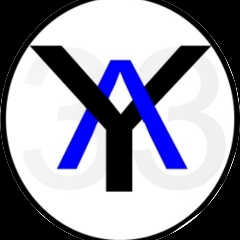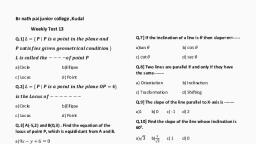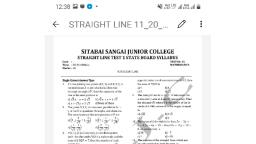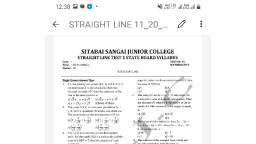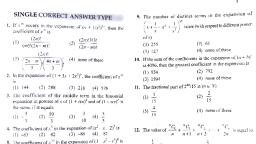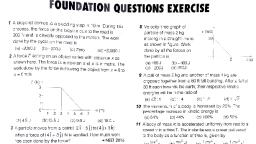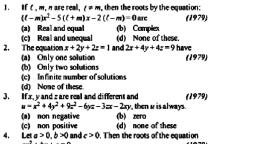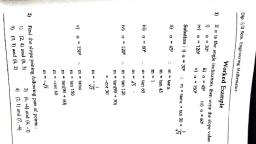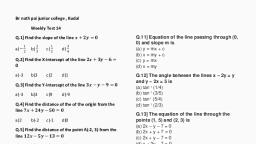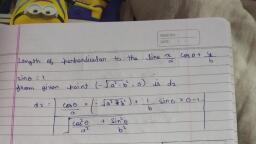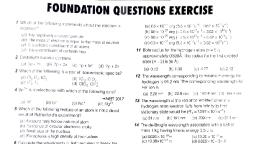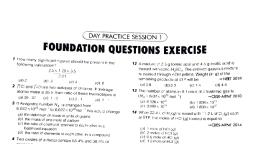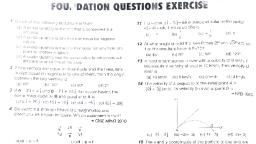Page 1 :
JEE Main 5 Years at, 1., , Let the orthocentre and centroid of a triangle be A(-3, 5), and B(3, 3) respectively. IfC is the circumcentre of this triangle, then the radius of the circle having line segment AC as, , diameter,1s:, (a), 2., , 5., , 3, , (c), , 35, , (a), 6., , x+y =2-V6, , 10, , 3 3, , 7, , Online 2015, , (3 23, 5 10, , (a), , B, (A, , then the locus, , B),, 7xy=6 (x+y), #, , of the midpoint of AB, , (b) 4 (x + y-28 (x +y) + 49=0, , (c) 6xy=7(X*y), d) 14 (x+y-97 (x+y)+ 168=0, , Online 2016], , (11 29, , 2010, , Thepoints0,(1,3) and (82, 30), (a), , form an acute angled triangle., , 8., , (b), (c), (d), Let, , form aright angled triangle., lie on a straight line., form an obtuse angled triangle., a, b, c and d be non-zero numbers. If the, , =l and + = 1 , meets the coordinate axes at A, and, , c), , 7., , (d) (-3,-8), (c) -3,-9), 4., 11avariable line drawn through the intersection of the lines, , is :, , x+y = 3-2V6, , Land L is:, , one ofthe following is a vertex of this rhombus? [2016, , (b), , (d), , be the line passing through the point P(1.2) such that, LetL, its intercepted segment between the co-ordinate axes is, , Tx-y-5=0. Ifits diagonals intersect at(-1,-2),then which, , 18, , (b) 2x+2y =l-v6, , bisected at P. IfL, is the line perpendicular to L and passing, through the point (-2, 1), then the point of intersection of, , (b), 3x +2y = xy, (a) 2x+3y= xy, (d) 3x+2y=6, c) 3x+2y= 6xy, Twosides of a rhombus are along the lines, x - y+1=0and, , (a), , Online 2016], , is:, , )x+y =3-3/6, , [2018, , 3., , point (2, 1) is translated parallel to the line L:x-y=4 by, 23 units. If the new points Q lies in the third quadrant,, , The, , perpendicular to L, , (d) V10, , 2, A straight line through a fixed point (2, 3) intersects the, coordinate axes at distinct points P and Q. IfO is the origin, and the rectangle OPRQ is completed, then the locus of Ris, , Glance, , then the equation of the line passing through Q and, , 2018], , 2/10 b), , a, , Online 20151, , point, , of, , intersection of the lines 4x+2ar+ c=0and 5hr +2by+ d=0, lies in the fourth quadrant and is equidistant from the two, , axesthen, (a) 3he-2ad 0, (c) 2bc-3ad =0, , (b), , 3he + 2ad=0, , (d) 2he+ 3ad-0, , 2014|
Page 2 :
1., , Ifthe point P(r, y) is equidistant from the points A(a, , +, , b,, , 4., , b-a) and B(a - b, a +b), then, ax, by, (b) br ay and P can be (a, b), (a), , I fthe intercept made on the line y = mx by linesy, , = 2 and, , y=6 is less than by 5 then the rangeof the value of m is, , ==, , =, , (c), , 2., , (a), , -y=2(ar +by), , (d) None of the above, Let O (0, 0). P(3, 4), andQ (6, 0) be the vertices, OPQ. The point R inside the triangle OPQ is such that the, , oftriangle, , triangles OPR, POR, OOR are of equal area., , (a), , (43,3) (b) (3,2/3), , (c)(3,4/3) (d) (4/3,2/3), The orthocentreoftriangle formed by lines 4x-7y +10=0,, , x+y=5and 7x+4y= 15 is, (a) (1.2), (b) (1, -2) (c)1,-2) (d) (,2), , -, , (d) None of these, , The coordi-, , nates of R are, 3., , (b), , 5., , Alightray coming along the line 3x +4y =5 gets reflected, a r + by, l and goes along the ine, , from the line, , =, , 5x-12y=10. Then,, (a) a=64/115, b=112/15, , (6), , (c), , (d), , a =64/115, b=-8/115, , a=, , 14/15, b=-8/115, , a=64/15, h= 14/15
Page 3 :
Aline AB makes zero intercepts on x -axis andy-axis and it, , perpendicular, , to another line, is, equation of line AB is, , CD,, , 3x, , +, , 4y, , +6, , 15., , intersection of, , 0. The, , (b) 4x-3y+8 0, (c) 4x-3y=0, (d) 4x-3y +6 0, A light ray emerging from the point source placed at, P(2,3), is reflected at a point Qon the y-axis. It then passes, through, the point R(5, 10). The coordinates of O are, , (a) (0,3), (c) (0,5), 8., , 17., , 18., , a square, then the equation of second diagonal is, , 9., , (a)x +3y=21, , (b) 2x-3y=7, , (c)x+7y=31, , (d) 2x+3y=21, , Ifthe linesy=3x + 1 and 2y=x+3, , m<3)., , liney= mx+4., , (a)(1t5/3), 7, , are, , then, , equally inclined to the, , 11., , 2, , (b, , 2, , 19., , 12/17, , (c), , 13/5, , (d), , 17/13, , (a) 27x+ay+2aT=0, , (b) 27x-a-y +2aT=0, , (c)27x-a'y-2aT=0, , (d), , None of these, , Given a family of lines a(2x +y+4) + b(x -2y-3)= 0, the, , 0, , (b), , (c), , 1, , 2, , (d), , 4, , I f x - 10xy +12y+ 5x- 16y-3 = 0 represents a pair of, , 1, , (b), , 2, , (c), , 5, , (d), , 4, , The image of the pair of lines represented by:, ax +2hxy +by = 0 by the line mirrory = 0is, (a), , a x - 2 h x y - by, , =0, , (b), , bx-2hxy + ay' = 0, , (d) ax-2hxy + by2 =0, The combined equation ofthe pair oflines through the point, , (c) br +2hxy+ ay=0, 23., , (1, 0) and parallel to the lines represented by, , 2x-xy-y', =0 is-4x-y, 2x-xy - y, , (a), , (d) 3x-3y-8xy-15y-20=0, , (b), , The number of lines that are parallel to 2x +6y + 7-0 and, , =0, , 2x-xy-y-4x + y+2 = 0, , (c) 2x+xy+y -2x+y =0, , have an intercept of length 10 between the coordinate axes is, , (b), , (6), , The equation of straight line passing through (-a, 0) and, , (a), , 22., , (c) 32-3y2 +8xy +10x+15y +20=0, , 1, , 36/13, , straight lines, then the value of Ais, , Let POR be a right-angled isosceles triangle, right angled at, P(2, 1). Ifthe equation ofthe line QR is 2x +y=3, then the, equation representing the pair of lines PO and PR is, , (a), , Ifapair of perpendicular straight lines drawn through the, , (a), 21., , (a) 3a2-32+8xy +20x+10y +25 =0, (b) 32-3y2 +8xy-20x-10y +25 =0, , 12., , b) (3,4), (d) 4,13), , fromP(2,-3) is, , (d), , 4, , (a)-1,-14), (c)(1,2), , (d), , number oflines belonging to the family at a distance y10, , t25, , (c), , (b) rhombus, , making a triangle with the axes of area Tis, , 20., , 10. For what value of p',y+xy +px-x-2y +p=0, represent 2 straight lines, , (a), , (a) parallelogram, (c) cyclic quadrilateral, , (a), , (b)t5 5, , (c)t52), , a+ b-c<0, , origin forms an isoscelestriangle with the line 2x+3y=6,, then area of the triangle so formed is, , the values of mare, , d), , a-b+c<0, , (d), , None of these, Thereflection of the point (4,-13) in the line 5x +y +6=0, is, , None of these, , If(-4, 5) is one vertex and 7x -y+ 8 =0is one diagonal of, , (6), , Points Plp, 0), Oq.0), R(O, p), S(0, 9) form, , 16., , (b) (0,2), (d), , thelines ax +by +c=0, , lessthan 22.Then, (a) a+b-c>0, c) a-b+c>0, , (a) y=4, , 1., , For a>b>c>0, the distance between (1, 1) and the point or, and bx + ay+c=0 is, , (d) None of these, , 2, 24., , (c) 4, (d) Infinitely many, 13. One vertex of an equilateral triangle is (2.3) and the equation, , A ray, , of light coming from the point (1,, , 2) is reflected, , point A on the x-axis and then passes through, (5,3). The co-ordinates of the point A is, , the, , at, , point, , ofline opposite to the vertex is x +y=2, then the equation, of remaining two sides are, , )y-3-(2tW3 )«-2) (b) y+3-(2tv3 ) «+2), , ()y+3=(3+2)r+2) d) y-3=(3+/2 )*-2), 14., , The value of ). for which the lines, , joining, , the, , points of, , intersection of curves C and C, to the origin are equally, , inclinedto theaxis ofx, where C,:hx2+3y-2A xy+9x=0, , andC,:3x-4y2+8xy-3x=0,is, , (a)= (b) à-12, , (c), , A=1, , (d) =, , 5, , 25., , (a), , (b), , c) -7,0), , (d) None of these, , Vertices ofa variable triangle are (3,4), (5 cos0, 5 sin6), , orthocentre is, , (a) (x+y-1} +(x-y-7} = 100, (b) (x+y-7)+(x-y-1) = 100, , (c) (r +y-7} + (x +y-1= 100, (d), , 6, , 0, , and (5 sin0, -5 cose), where 6e R. Locus of it's, , (x + y - 7, , +(x-y+1)* = 100, , a
Page 4 :
26., , It the, , angle, , betveen the two lines, , 21+511 31+6r 71+ 4, +, , 27., 27., , 0, , istan'm, then m is equal to:, , (b), , (a), , (e), , +, , 28., , represented by, , (d), , 1, , (a), , 7, , 29., , 5, , sides BC. CA, A irL intersects the three, , and 4B ofa, , BP CO AR, AABCat P Oand R respectively. Then, PC OA, cqual to, , (a), , (c) -1, , The distance of the line Zr y=5, direction whose slope is 1, is, , (b), , 0, , (d), , None of these, , RB, , (c), , 3, , point (1,3)in tho, , 22, 3, , (d), , 25, 3, , The circumcentre of triangle lies at the origin and i, centroid is the mid point of the line segment joining the, points (a+ 1, a+ 1) and (2a, -2a). a #0. Then for anya,the, orthocentre of this triangle lies on the line:, a, , (b) y-(a+1 )x =0, , (c), , y-2ax 0, y+x 0, , (a), , y-5 =0, , (b), , x-5 =0, , (c), , 2x+3y-7=0, , (d), , None of these, , (a), , 30., , (b), , 3, , TOm ine, , =, , =, , (d) (a-1)°x-(a+ 1fy =0, , The vertices of atriangle ABC are (1, 1), (4,-2) and (5,5, respectively. Then equation ofperpendicular dropped from, C to the internal bisector of angle A is
